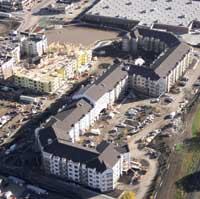Dollars and Sense Finding funding for the mixed-income Landings was nearly as complex as designing the project.
Dominium covered most of the project’s $50 million price tag with $40 million in tax-exempt bonds from the city of St. Anthony. Because the project has an affordable component, it also qualified for federal HOME funds through Minnesota’s Ramsey County. (The HOME Investment Partnerships Program is the largest federal block grant to state and local governments designed exclusively to produce affordable housing for low-income families.)
Interim financing for a portion of the costs was provided by Minnwest Bank, and LaSalle Bank issued a letter of credit for the project.
David Larsen, senior vice president of LaSalle Bank, says the project was appealing for a number of reasons. “The economics worked pretty well,” he says. “And the deal was enhanced by tax-exempt bonds. That made it a financially feasible project.”
(Some greyfield projects are more complicated to finance than others. If there are serious environmental concerns–like asbestos or lead paint, in addition to soil contamination–the clean-up can make the deals harder to sell to public and private financiers. Solid due diligence and a level two or three environmental assessment will likely uncover these issues before the deal progresses too far.)
Because it can often take two years to revamp these properties, it can be difficult to keep buyers interested. Lenders like to see strong pre-sales, so a design that compels residents to stick with the project is key.
Finally, restrictive leases with retail tenants can mean costly buyouts or, worse, expensive eminent domain court cases. Reviewing current lease terms prior to closing the deal–and offering competitive buyouts before things get heated–are the best solutions.
But the Landings had successfully addressed its environmental challenges and had other things going for it, like its location. “The multifamily market in Minneapolis has been stable forever and a day,” Larsen says. “So for a long, long stretch, multifamily’s been a no-brainer because of pent-up demand.”
But what really sold him, Larsen says, was Dominium’s reputation. The bank has been doing business with the developer for four years, and the team has done five or six similar projects in that time. “You can look at pro formas and locations, but that’s not enough,” he explains. “We have to believe in the experience of developers to get it built and an experienced management team that knows how to get it leased.”
